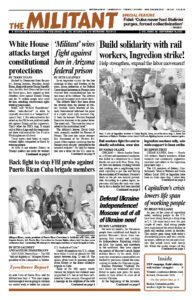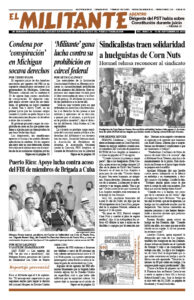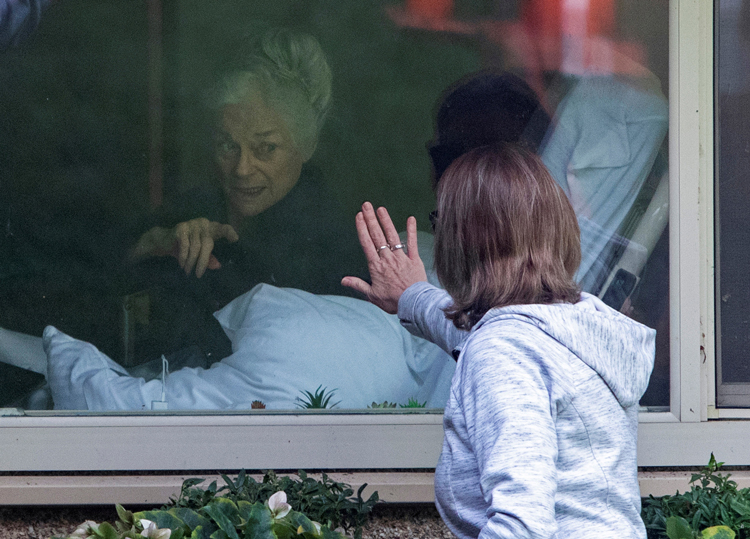As part of the crisis of capitalism today, working people in the U.S. have been living through a sharp drop in U.S. life expectancy over the past couple of years. And young people have experienced the worst decline in math and reading scores in decades. This reality goes along with today’s skyrocketing prices and boss attacks on wages, safety on the job and schedules that wreak havoc with family life. While the media blames all this on the COVID-19 pandemic, it has much deeper roots.
From 2019 to 2021, people here lost 2.7 years from their anticipated life span, dropping it to 76.1 years, according to the National Center for Health Statistics. The last time life expectancy fell that much was in the early 1940s, part of the carnage working people lived through during the second imperialist world war.
These conditions fall disproportionately harder on African Americans, whose anticipated life expectancy is 70.8 years today, compared with 76.4 years for Caucasians. The most precipitous drop was for Native Americans and Alaska Natives, whose life expectancy fell by six and a half years to 65.2 years.
Life expectancy has been declining for years, beginning well before the pandemic. From 1959 to 2010, the U.S. average life span increased from 69.9 to 78.9 years old. But in 2011, on the heels of the 2008 economic crisis, it stopped growing and since 2014 has been declining.
While more than 1 million people in the U.S. have died from COVID, many have lost their lives from what the media terms “unintentional injuries.” This covers up for the scourge of opioid drug overdoses, suicides and the sharp drop in the availability of quality and affordable health care for millions of workers.
Deaths from drug overdoses rose by 15% in 2021 to nearly 108,000 people. Since 1999 there have been some 1 million drug deaths in the U.S., many from the recent spread of fentanyl in the drugs being sold on the street. Drug use, alcoholism and suicide rates are highest in regions where industries have been shut down and good-paying jobs are hard to come by. In West Virginia, for example, where coal-mining jobs have been decimated, deaths due to overdoses are more than double the national average.
U.S. suicide rates rose by 35% between 2000 and 2018, with nearly half a million people taking their own lives from 2010 to 2020. The highest rates were among teenagers and young adults.
At the same time, the percentage of workers who had union protection declined — now standing at 6.1% in private employment.
Over these years — before the pandemic — boss and government attacks on our jobs, wages, working conditions, health care, social services and our unions had battered the working class. The Bill Clinton administration’s decision in 1996 to shut down “welfare as we know it” led the number of families below the poverty line receiving benefits to plunge from nearly 70% to just 23%.
How capitalist gov’t handled COVID
The capitalist rulers responded to the COVID pandemic with widespread government-ordered lockdowns, and the decision to shut down all other health care services for working people. Nursing homes turned into death traps, and residents’ families were barred from visiting.
Under capitalism, the medical industry runs as a business to maximize profits for the hospital and giant pharmaceutical company bosses. This has had an especially big impact in the countryside, where more than 130 rural hospitals have closed over the past decade and over 600 additional rural hospitals — 30% of all rural hospitals in the country — may close in the near future.
With prices soaring, especially in necessities like food and fuel, and good-paying jobs scarce, young workers face increasing difficulties in being able to form and afford a family. This is reflected in declining U.S. birth rates, which over the past 15 years have dropped by 20%. The costs for a working-class family to raise a child through high school has risen to over $300,000.
Drop in reading, math scores
National test scores released by the National Assessment of Educational Progress Sept. 1 indicate that the performance of 9 year olds in math and reading dropped to the lowest level since the 1990s. The results were class-divided, with reading scores for students from low-income working-class families falling twice as much as those from wealthy or higher middle-income backgrounds.
Making the situation worse were government-imposed school closures during the pandemic, in some cases for more than a year. Students were supposed to master lessons through computer Zoom sessions, or rely entirely on their family — where parents were pressed to stay home to provide day care and education for their children.
This was a far more difficult way to learn, with young people denied the help of teachers and social interaction with others their own age.
Under capitalism, and its sharpening class inequalities today, the propertied rulers care little about education for working-class youth. Most young people never get taught they have anything to look forward to after getting out of school, except maybe more debt. They’re thrown out into an ever worsening “job market,” as the bosses look for every opportunity to boost profits at our expense. They drive to make us produce more, with less and less workers, and schedules that are simply unlivable.
The most important new thing today is the strikes and social struggles taking place. They are “part of preparing the working class for the battle to throw off the self-image the rulers teach us, and to recognize we’re capable of taking power and reorganizing society,” as Socialist Workers Party National Secretary Jack Barnes explains in Are They Rich Because They’re Smart? Class, Privilege, and Learning Under Capitalism.


